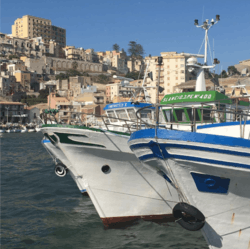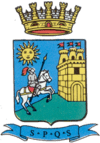Sciacca
| Sciacca | ||
|---|---|---|
| Comune | ||
| Comune di Sciacca | ||
 | ||
| ||
 Sciacca Location of Sciacca in Italy | ||
| Coordinates: 37°30′33″N 13°5′20″E / 37.50917°N 13.08889°E | ||
| Country | Italy | |
| Region | Sicily | |
| Province | Agrigento (AG) | |
| Frazioni | Lazzarino | |
| Government | ||
| • Mayor | Francesca Valenti | |
| Area | ||
| • Total | 191.67 km2 (74.00 sq mi) | |
| Elevation | 60 m (200 ft) | |
| Population (31 March 2017) | ||
| • Total | 40,569 | |
| • Density | 210/km2 (550/sq mi) | |
| Demonym(s) | Saccensi, Sciacchitani | |
| Time zone | UTC+1 (CET) | |
| • Summer (DST) | UTC+2 (CEST) | |
| Postal code | 92019 | |
| Dialing code | 0925 | |
| Patron saint | Holy Mary of Soccorso | |
| Saint day | 2 February | |
| Website | Official website | |
Sciacca (Italian: [ˈʃakka]; Greek: Θέρμαι; Latin: Thermae Selinuntinae, Thermae Selinuntiae, Thermae, Aquae Labrodes and Aquae Labodes), is a town and comune in the province of Agrigento on the southwestern coast of Sicily, southern Italy. It has views of the Mediterranean Sea.
History
Thermae was founded in the 5th century BC by the Greeks, as its name imports, as a thermal spa for Selinunte, whose citizens came there to bathe in the sulphurous springs of Mount San Calogero, which rises up behind the town. We have no account of the existence of a town on the site during the period of the independence of Selinunte, though there is little doubt that the thermal waters would always have attracted some population to the spot. Nor even under the Romans did the place attain to anything like the same importance with the northern Thermae; and there is little doubt that Pliny is mistaken in assigning the rank of a colonia to the southern instead of the northern town of the name. Strabo mentions the waters (τὰ ὕδατα τὰ Σελινούντια[1]); and they are again noticed in the Itineraries under the name of Aquae Labodes or Labrodes.[2]
The origins of the town's name have been much debated, with Latin "ex acqua", as a reference to the springs of thermal water of the area, or Arabic "Syac", meaning bath, and al Saqquah, dating back to the cult of the Syrian god "Shai al Quaaum", as possibilities.
The city walls, the bastions and the Old Castle owe their existence to Roger the Great Count.
A royal city which had remained faithful to Manfred of Sicily during the Angevine invasion, by 1268 A.D. it was besieged by Charles I of Anjou and surrendered the following year. After the Sicilian Vespers, it established itself as a free commune. During the Aragonese-Angevine wars it was besieged numerous times, after which the Peralta family took possession of it and obtained by the king of Sicily the right to mint coins. In the following centuries the town was at the center of bloody feuds between rival baronial families (the Luna, of Aragonese origin, and the Perollo, of Norman stock), which nearly halved its population. In 1647 the impoverished town was the seat of an anti-Spanish rebellion.
During World War II the Italian Regia Aeronautica (Royal Air Force) had a base near Sciacca.
Geography
Overview
The municipality borders Caltabellotta, Menfi, Ribera and Sambuca di Sicilia.[3]
Climate
| Climate data for Sciacca, Italy | |||||||||||||
|---|---|---|---|---|---|---|---|---|---|---|---|---|---|
| Month | Jan | Feb | Mar | Apr | May | Jun | Jul | Aug | Sep | Oct | Nov | Dec | Year |
| Average high °F (°C) | 57 (14) |
57 (14) |
60 (16) |
64 (18) |
72 (22) |
79 (26) |
83 (28) |
85 (29) |
80 (27) |
74 (23) |
66 (19) |
59 (15) |
69.666 (20.926) |
| Average low °F (°C) | 51 (11) |
50 (10) |
52 (11) |
55 (13) |
61 (16) |
68 (20) |
72 (22) |
75 (24) |
71 (22) |
65 (18) |
59 (15) |
53 (12) |
61 (16) |
Source: <World Weather Online= >Sciacca Monthly Climate Average, Italy. World Weather Online. 2016 http://www.worldweatheronline.com/sciacca-weather-averages/sicilia/it.aspx. Retrieved 14 September 2016. Missing or empty |title= (help)
| |||||||||||||
Main sights
Sciacca still retains much of its medieval layout, which divided the town into quarters, each laid out on a strip of rock descending toward the sea. Sciacca has several points of interest, including:
- the Cathedral of Maria SS. del Soccorso (12th century, rebuilt in 1685)
- the Castle of the Counts Luna. Of the Old Castle scarce remains can be still seen.
- church of Santa Margherita
- Chiesa del Carmine
- Church of San Michele (1371, rebuilt in the 17th century)
- Church of Santa Maria delle Giummare
- Palazzo Steripinto
- Palazzo Tagliavia (11th century), in Neo-Gothic style
- Palazzo Perollo (15th century)
Culture
Sciacca's festivals include the Carnival, celebrated during the week before the beginning of Lent (February). The highlight of the festival is the parade of bizarre figures mounted on floats, famous throughout Sicily for their gaudy expressions. Sciacca is also the hometown of the Mediterranean Scene.
Starting near the turn of the 20th century, a number of residents of the Sciacca area emigrated to the North End of Boston, Mass., where, starting in 1910, around August 15, their descendants, especially those from fishing families, have celebrated the Festival of the Madonna del Soccorso .
Economy
The economy of Sciacca is mainly based on agriculture, fishing and related food processing industry and tourism.
Sister cities



People
- Luigi Pirandello, born in Agrigento, Sicily, 28 June 1867, and deceased in Rome 10 December 193, was an Italian dramatist, novelist, poet and short story writer. He was awarded the 1934 Nobel Prize in Literature. Pirandello's works include novels, hundreds of short stories, and about 40 plays, some of which are written in Sicilian.
- Tommaso Fazello, was born in Sciacca. Authored the first printed history of Sicily De Rebus Siculis Decades Duae, published in Palermo in 1558
- Giovanni Antonio Medrano, one of the architects who designed the San Carlo opera house in Naples in 1737, was born in Sciacca
- Baroque liturgical composer Cataldo Amodei was born at Sciacca around 1650
- American baseball player Mike Piazza's family origins are in Sciacca
- Johnny Dundee, world featherweight and Super featherweight champion of the 1920s, was born in Sciacca and later emigrated to America
- Giuseppe Mario Bellanca, the airplane designer and builder who created the first monoplane in the United States with an enclosed cabin, was born in Sciacca
- The Costa family, who ran many American underground facilities during the 1920s, have origins in Sciacca
- American musician and educator Richard Termini's grandfather came from Sciacca.
- Giacomo Puleo, Italian Politician
- The parents of American cartoonist Joseph Barbera (of Hanna-Barbera fame) were born in Sciacca
- American musician Jon Bon Jovi is descended from emigrants from Sciacca
- American singer Alicia Keys is descended from emigrants from Sciacca
- American humorist Troy Sciacca ancestors came from Sciacca
References
- ↑ Strabo, vi. p. 275
- ↑ Itin. Ant. p. 89; Tabula Peutingeriana
- ↑ 39255 Sciacca on OpenStreetMap
External links
| Wikimedia Commons has media related to Sciacca. |

- Guide to Sciacca (in Italian)

